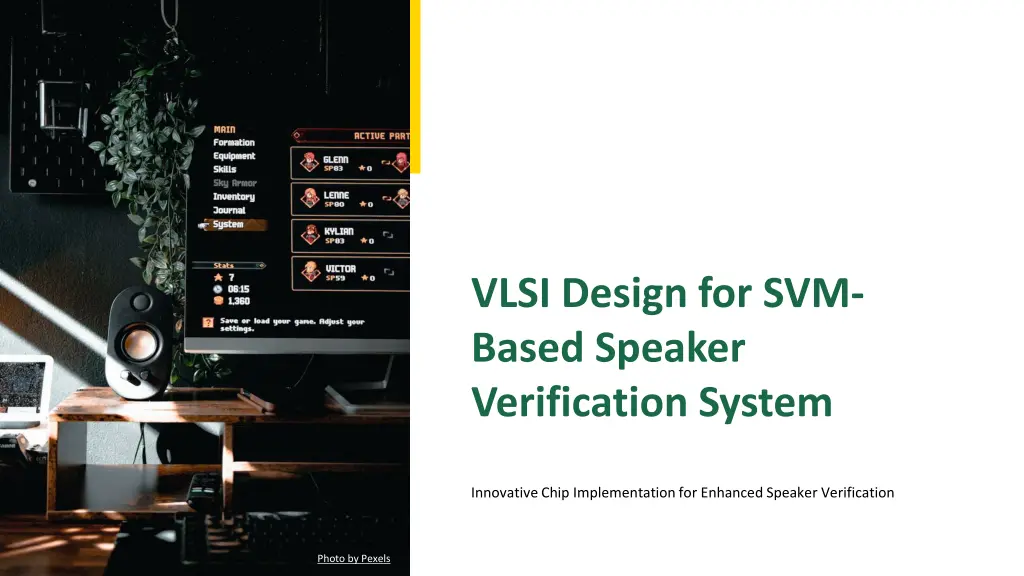
Innovative VLSI Design for Enhanced Speaker Verification System
"Explore the innovative VLSI design integrating SVM for enhanced speaker verification system. Learn about chip implementation, testing, applications, and future impact. Discover the synergy of machine learning and hardware implementation in speaker verification. Photo by Pexels."
Download Presentation

Please find below an Image/Link to download the presentation.
The content on the website is provided AS IS for your information and personal use only. It may not be sold, licensed, or shared on other websites without obtaining consent from the author. If you encounter any issues during the download, it is possible that the publisher has removed the file from their server.
You are allowed to download the files provided on this website for personal or commercial use, subject to the condition that they are used lawfully. All files are the property of their respective owners.
The content on the website is provided AS IS for your information and personal use only. It may not be sold, licensed, or shared on other websites without obtaining consent from the author.
E N D
Presentation Transcript
VLSI Design for SVM- Based Speaker Verification System Innovative Chip Implementation for Enhanced Speaker Verification Photo by Pexels
01 Introduction to VLSI Design Table of Contents 02 Speaker Verification Systems 03 SVM in Speaker Verification 04 VLSI Design for SVM 05 Chip Implementation 06 Testing and Validation 07 Applications and Impact 08 Future of VLSI and SVM 09 Conclusion 10 Q&A Session
1 Introduction to VLSI Design Understanding the Basics VLSI stands for Very-Large-Scale Integration, a process of creating integrated circuits by combining thousands of transistors into a single chip. VLSI technology is crucial for the development of modern electronic devices, enabling more complex and efficient systems. Used in various fields such as computing, telecommunications, and consumer electronics. Includes issues like power consumption, heat dissipation, and design complexity. Photo by Pexels
2 Speaker Verification Systems Ensuring Secure and Accurate Identification A biometric process that uses voice patterns to verify a speaker's identity. Used in security systems, banking, and personal devices for authentication. Includes dealing with noise, voice changes, and ensuring accuracy. Support Vector Machines (SVM) are used to improve the accuracy and reliability of speaker verification systems. Photo by Pexels
3 SVM in Speaker Verification Leveraging Machine Learning for Better Results Support Vector Machine is a supervised machine learning model used for classification and regression tasks. SVM helps in distinguishing between different speakers by analyzing voice patterns. Provides high accuracy, robustness, and efficiency in speaker verification. Requires careful tuning and large datasets for optimal performance. Photo by Pexels
4 VLSI Design for SVM Integrating SVM into VLSI for Enhanced Performance Combining SVM with VLSI design enhances the speed and efficiency of speaker verification systems. Focus on optimizing power, area, and speed for the integrated system. Includes managing complexity and ensuring compatibility with existing systems. Results in a compact, efficient, and high-performance speaker verification system. Photo by Pexels
5 Chip Implementation Realizing the Design in Hardware The process of translatingthe VLSI design into a physical chip. Includes design, fabrication, testing, and validation. Ensuring accuracy, managing costs, and meeting design specifications. Examples of successful chip implementations in the industry. Photo by Pexels
6 Testing and Validation Ensuring Reliability and Performance Critical for verifying the functionality and performance of the chip. Includes functional, performance, and stress testing. Methods used to ensure the chip meets all design requirements. Strategies to address common testing issues and ensure reliability. Photo by Pexels
7 Applications and Impact Real-World Uses and Benefits Includes telecommunications, security, and consumer electronics. Enhances the accuracy and reliability of biometric security systems. Potential for further advancements and applications in various fields. Real-world examples of successful implementations and their impact. Photo by Pexels
8 Future of VLSI and SVM Trends and Innovations Includes advancements in AI, machine learning, and semiconductor technology. New techniques and materials for improved performance and efficiency. Addressing issues like scalability, power consumption, and integration. Potential for new applications and markets in the coming years. Photo by Pexels
9 Conclusion Summarizing Key Insights Summary of the main topics covered in the presentation. Highlighting the significance of these technologies in modern systems. Concluding remarks on the future and potential of VLSI and SVM. Encouraging furtherexploration and innovation in this field. Photo by Pexels
10 Q&A Session Addressing Audience Queries Inviting the audience to ask questions and seek clarifications. Discussing frequently asked questions and providing detailed answers. Sharing additional insights and perspectives from industry experts. Thanking the audience and providing contact information for follow-up. Photo by Pexels
